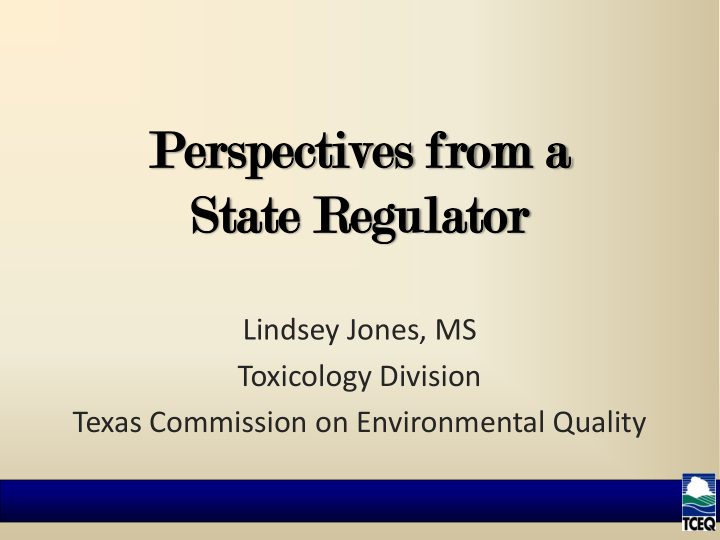



Pers rspec ecti tives ves fr from a m a Sta tate te Re Regu gula lato tor Lindsey Jones, MS Toxicology Division Texas Commission on Environmental Quality
Environmental Regulation in Texas • The Texas Commission on Environmental Quality strives to protect our state's human and natural resources consistent with sustainable economic development • Our goal is clean air, clean water, and the safe management of waste
Toxicology Division • Provide scientifically-sound support for various parts of the agency – Develop Effects Screening Levels (ESLs) and Air Monitoring Comparison Values (AMCVs) – Perform health effects review of air permit applications – Provide risk assessments of environmental data (air, drinking water, surface water, soil, waste) – Stay abreast of emerging issues • Comment on EPA toxicity values (arsenic, formaldehyde, ozone) – Characterize and communicate risk
Challenges • Develop guidelines for the over 5,000 chemicals emitted by permitted facilities
Challenges • Appreciating the difference between actual and perceived risk 390 TPY VOCs 61 TPY VOCs 1.2 ppb Benzene 2005 0.2 ppb Benzene 2005 Davis Petroleum, Shoreacres TXI Operations, Midlothian
Sound Science • Protection of human health is the highest priority • High quality information to risk managers to make better-informed decisions • Imperfect data uncertainty factors
Guideline Levels • Guidelines to establish Air concentration In parts per billion (ppb) screening levels Long-Term 1,000,000 Health Effect (November 2006) 100,000 – External scientific peer review Leukemia 10,000 – 2 rounds public comment 1,000 – 36 chemicals completed to date 100 • Public comment EPA Acceptable 10 • Peer review for some Cancer Risk • Values are conservative TCEQ Long-Term 1 AMCV = 1.4 ppb 0.1
Guideline Implementation • Regardless of how conservative guidelines are set, they become definitive lines to the media and public – Carbon disulfide • Concern rises when there is conflicting information – Methyl mercury
Importance of Risk Assessment Worst-Case Scenario + Uncertainty Factors Reality • Policy decisions come with a price – Money, resources, opportunities • Realism is a key component of risk assessment • Ripple effects can be staggering
Formaldehyde • 2008 TCEQ nonlinear carcinogenic assessment set the Long-Term AMCV at 8.9 ppb • 2010 draft EPA linear carcinogenic assessment sets its level at 0.08 ppb – Leukemia and Hodgkin lymphoma – Nasopharyngeal cancer • TCEQ provided comments on the EPA draft
Annual Average Formaldehyde Concentrations in the Houston Region 10 2005 2006 2007 2008 2009 TCEQ Long-Term Air Monitoring ComparisonValue = 8.9 ppb 9 8 Formaldehyde Concentration (ppbv) 7 6 California EPA 1 in 100,000 Risk Level – 1.4 ppb 5 1991 IRIS 1 in 100,000 Risk Level – 0.6 ppb * 4 2010 Draft IRIS 1 in 100,000 Risk Level – 0.07 ppb 3 2 1 0 Channelview Clinton Houston Deer Park * Incomplete sampling year
Typical Formaldehyde Concentrations 10 2005 2006 2007 2008 2009 TCEQ Long-Term AMCV - 8.9 ppb 9 8 2009 Range of Annual Average Formaldehyde Concentrations in the US Formaldehyde Concentration (ppbv) 7 (0.75 - 9.4 ppb) (Source: AQS, USEPA) 1 6 California EPA 1 in 100,000 Risk Level - 1.4 ppb 5 1991 IRIS 1 in 100,000 Risk Level - 0.6 ppb * Draft 2010 IRIS 1 in 100,000 Risk Level - 0.07 ppb 4 3 2 1 0 Channelview Clinton Houston Deer Park 1 Only sites with 24-hour sample durations and greater than 25 samples were included * Incomplete sampling year
Typical Formaldehyde Concentrations 45 2005 2006 2007 2008 2009 40 35 Formaldehyde Concentration (ppbv) 30 Range of Normal 25 Human Breath (4.3 - 40 ppb) 20 15 10 TCEQ Long-Term AMCV - 8.9 ppb California EPA 1 in 100,000 Risk Level - 1.4 ppb 2009 Range of Annual Average 1991 IRIS 1 in 100,000 Risk Level - 0.6 ppb Formaldehyde Concentrations in the US 5 * Draft 2010 IRIS 1 in 100,000 Risk Level - 0.07 ppb (0.75 - 9.4 ppb) (Source: AQS, USEPA) 1 0 Channelview Clinton Houston Deer Park * Incomplete sampling year 1 Only sites with 24-hour sample durations and greater than 25 samples were included
Typical Formaldehyde Concentrations 45 2005 2006 2007 2008 2009 40 35 Formaldehyde Concentration (ppbv) 30 Range of Normal Typical Indoor Air Human Breath 25 (9 - 39.8 ppb) (4.3 - 40 ppb) 20 15 10 TCEQ Long-Term AMCV - 8.9 ppb California EPA 1 in 100,000 Risk Level - 1.4 ppb 2009 Range of Annual Average 1991 IRIS 1 in 100,000 Risk Level - 0.6 ppb Formaldehyde Concentrations in the US 5 * Draft 2010 IRIS 1 in 100,000 Risk Level - 0.07 ppb (0.75 - 9.4 ppb) (Source: AQS, USEPA) 1 0 Channelview Clinton Houston Deer Park * Incomplete sampling year 1 Only sites with 24-hour sample durations and greater than 25 samples were included
Resource Impacts ~ > 6 million ~ 4 million • Monitoring annually annually – > 60% of the state’s monitoring budget is spent Air Toxics Criteria Pollutant and Special Monitoring on monitoring for criteria Purpose pollutants – Federally-required monitoring under new NAAQS will cost > $3.5 million over the next 4 yrs
TAR ARGET ETED ED RE REDUCT CTION IONS
1,3-Butadiene in Milby Park • > $20 million invested by just TPC Group • Fenceline monitoring and notification system • Flare reduction strategies • 87% reduction in annual average concentrations
Barnett Shale Formation • 2005 HAWK Flyover • 6 mobile monitoring projects since 2009 • From August 2009- August 2010 – GasFindIR – 600 sites – 450 sites with hand-held monitor – 360 canister samples • 5 autoGC sites installed • 8 more autoGC sites proposed
Conclusion • Dose-response assessments are important – Translate to environmental concentrations – If everything is bad, then nothing will be fixed
Contact Information Lindsey Jones ljones@tceq.state.tx.us (512) 239-1784
Recommend
More recommend